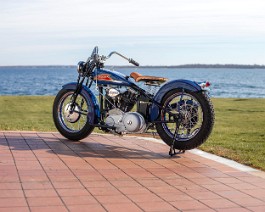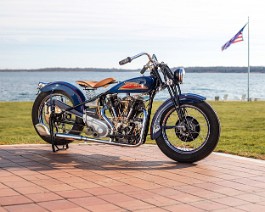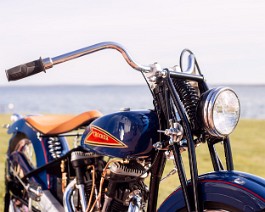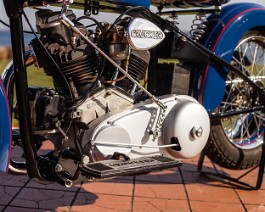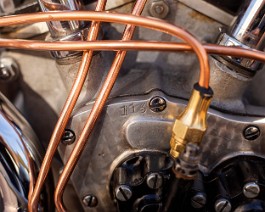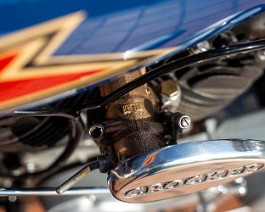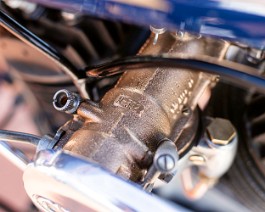1940 Crocker Small Tank V-Twin
Inventory Number: 5005
$575,000
- Serial Number 40-61-113
- Engine rebuilt by the late Dale Walksler, of Wheels Through Time Museum, Maggie Valley, North Carolina
- Listed in the Crocker Registry as “Dale's Burnout Special”
- This Crocker engine no. 40-61-113 powered the original "Dale Walksler Burnout Crocker"
- Accurately restored to honor one of the most iconic America built motorcycles
- 62 CI OHV air-cooled V-twin rated at 50 HP
- Schebler carburetor
- Magneto ignition
- Two-into-one exhaust with cannister muffler
- Steel fuel tank and fenders
- Sprung solo saddle
- Frame tubing painted black, fenders and fuel tank blue with red accents
- 4-speed manual transmission
- Tank side hand shift
- Foot operated clutch
- Chain final drive
- Kick starter
- Girder forks
- Rigid rear frame
- Cast aluminum footboards
- Electric headlamp and taillamp
- 7 inch single-leading shoe front brake
- 7 inch single-leading shoe rear brake
- 3.5-18 front and 3.5-18 rear tires
- Wire spoke wheels with steel rims
- Crocker built its first OHV V-twin roadster in 1935
- Limited production through 1940
- Tied with Vincent for the fastest production motorcycle in the world in 1936
“Rare surviving Crocker V-twins are now the most valuable American motorcycles ever made, they sit shoulder to shoulder with the legendary machines from Brough Superior and Vincent as the most desirable collector motorcycles of all time.
“Even among motorcycles as rare as Crockers there are a few that are extra special, and this is one such example… Every Crocker was built to order, and no two are the same… The nickname [“Dale’s Burnout Special] comes from Dale Walksler, the founder and curator of the Wheels Through Time Museum in Maggie Valley, North Carolina. This Crocker became known as the burnout special because, as you may have guessed, Dale used to do burnouts on it to showcase the bike’s prodigious power to museum guests… Today there are 68 known surviving Crocker V-twins and they’re among the most valuable motorcycles in the world.” -SILODROME GASOLINE CULTURE: The Crocker V-Twin - A Rare American Motorcycle Worth Almost A Million Dollars by Ben Branch
“Designed during 1934-35, the Crocker big twin was intended as a durable and powerful, yet fast and nimble machine… While Bigsby made the patterns, most castings were subcontracted, then machined in-house. The heavy steel gearbox formed part of the lower frame, its case being brazed in place, its 3-speed gears and shafts so overbuilt that damage is unheard of even today… Their most unusual feature was a pair of cast-aluminum fuel/oil tanks, holding 2.5 gallons initially (the ‘Small Tank’ models). Crocker had built the fastest production motorcycle in the US, with speeds over 110mph the norm… built in small numbers for a very discerning clientele.”
-THE VINTAGENT: The Crocker Story By Paul d’Orleans
This rare and valuable motorcycle has gone through an extensive rebuild and restoration to honor one of the most iconic motorcycles in American history. Built to customer-specified engine capacity and power output, this “small tank” is one of a kind.
CROCKER HISTORY:
American Al Crocker was born in 1882, and after graduating with an engineering degree from Northwestern University, he went to work for the Aurora Automatic Machine Co., the builders of Thor motorcycles. He helped develop Thor engineering and became a successful racer from 1907- 1909 where he met Oscar Hedstrom and Charles Hendee, the chief engineer and owner of the Hendee Manufacturing Co., manufacturers of Indian motorcycles. By 1919, Crocker had opened his own Indian dealership in Denver, Colorado, by 1924, he took over the Kansas City dealership, but six years later, he couldn’t ignore the call of the west.
He moved to Los Angeles, California and opened a motorcycle repair shop selling used Indian and Harley-Davidsons, the Crocker Motorcycle Company. There in 1931, he began designing speed accessories, including steering dampeners and overhead-valve conversion kits, for Indian motorcycles. The same year, he began building and racing Speedway racers and by 1933, racers Jack and Cordy Mine took nine first place wins and three second place out of twelve starts on his designs.
It’s estimated that Crocker made only thirty-one of the Speedways before turning his attention to a new project - developing a large displacement V-twin roadworthy bike to compete against Harley-Davidson and Indian. From 1934-1935, with the help of Paul Bigsby, Crocker achieved his goal and completed a new overhead-valve 1,000cc V-twin with hemispherical combustion chambers and 50HP, making it one of the most power motorcycles in the world at the time. Crocker's first OHV V-twin roadster came out in 1935 and Harley-Davidson wouldn’t introduce their slower and heavier first OHV V-twin (the EL ‘Knucklehead’) until six months later. “To give his Crockers an extended range, the size of the cast-aluminum fuel tanks were enlarged in 1938, making all earlier models ‘Small Tanks’, and later models ‘Big Tanks’.” (Vintagent)
By 1936, Crocker was tied with Vincent Motorcycles for the fastest production motorcycle in the world. Part production was often outsourced but manufacturing was limited through 1940, as each bike was made to order to the specifications of their clientele. “Al Crocker was so confident that his motorcycles were the best in the country that he offered a money back guarantee to any rider who was beaten by an Indian or a Harley-Davidson. No one ever came looking for that refund.” (Silodrome)
In 1940, Crocker began to produce a motor scooter deemed the Scootabout, but with the entry of the United States into WWII, vehicle production ceased. Crocker Manufacturing would undertake war production for the duration, moving from their iconic Los Angeles location. It wasn’t until 1999 that the Crocker Motorcycle Company was revived in Southern California to manufacture replacement parts for Small and Big Tank Crockers. Today, Crocker V-twins are among the world’s most expensive motorcycles.
TOP 100 MOST EXPENSIVE MOTORCYCLES BY THE VINTAGENT
4. 1938 Crocker Small Tank $880K (2025)
6. 1936 Crocker Small Tank $825K (2019)
7. 1937 Crocker Small Tank $715 (2015)
8. 1939 Crocker Big Tank $074K (2019)
10. 1940 Crocker Big Tank $550K (2019)
24. 1937 Crocker Small Tank $423K (2019)
30. 1942 Crocker Big Tank $385K (2015)
36. 1938 Crocker Small Tank $371.8K (2016)
55. 1939 Crocker Small Tank $302.5K (2008)
56. 1940 Crock Big Tank Twin $302K (2012)
61. 1937 Small Tank Twin $291K (2012)
66. 1937 Crocker Hemi-Head $183.1K (2006)
77. 1941 Crocker Big Tank $243.8K (2007)
81. 1939 Crocker Small Tank $236.5 (2006)
82. 1939 Crocker V-twin Big Twin $233.2K (2008)
-As compiled by Mecum Auctions


